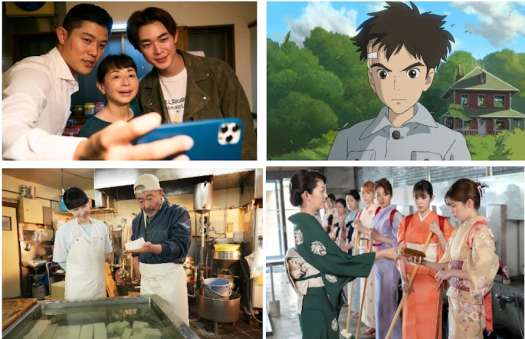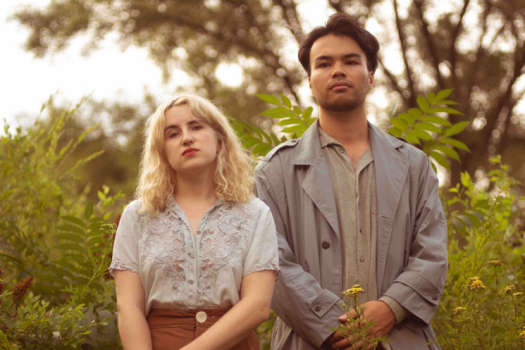"We were thinking about the tornados in Norman, Oklahoma," says Shovels & Rope's Michael Trent, "and the devastation they caused. But we wanted to strike a hopeful note about it." This, a description of the thinking behind new song "After The Storm," neatly encapsulates the basic thrust of the Charleston, SC duo's best work. Darkness and light are never far apart, and they won't let you forget it. "I mean, we're named Shovels & Rope," he adds.
It's a great handle for a folk band. Though they're commonplace implements, a working man's standard tools, a good shovel and some rope would also come in pretty handy if you had to kidnap, kill and bury someone. At every turn, all those old murder ballads remind us, there is the potential for evil in the mundane. And in the hands of these two, those old murder ballads have come back to haunt us yet again. With their madly assured new record, Swimin' Time, they stand poised to haunt us for a long time to come.
Like many of their peers in the alt-folk scene, Cary Ann Hearst and Michael Trent seek out new space in the old forms, manipulating classic-feeling tales of woe and worry into fresh, contemporary tunes. Yet, the married duo have risen above much of the pack with their fruitful, collaborative approach to songwriting. Though they shrug it off ("Oh, I just bring him a little something so he can finish it!" laughs Hearst), their two heads really do seem to be better than one. Indeed, the scrappy little group's semi-autobiographical "Birmingham" (a standout on their breakthrough sophomore record O Be Joyful) was exalted as "song of the year" by the Americana Music Association, a mighty honour in a crowded field. "That sure set a bar for us," says a modest Trent. "We just have to keep writing better songs."
But fans of the band know that it is their live performances that define the mostly acoustic duo. Their shows are sweaty, intimate, sexy and boisterous affairs, closer in spirit to cowpunk than the Carter Family. "I grew up in Nashville," explains Hearst, "so that music was unavoidable. But the Pixies, Nirvana — those were the bands I was listening to."
Trent agrees, especially after I offer that their stage presence conjures an image of Exene Cervanka and John Doe (of '80s-era rockers X) before it does Johnny Cash and June Carter Cash. "Yeah, X. We had never actually listened to them before we got together, so I can't say it's an influence, but now that we know their music, we really love the comparison. But the Cramps were more the thing we had on our minds!"
"We've had a lot of comparisons to Johnny and June and Gillian Welch and David Rawlings" adds Hearst, "and that was amazing, but neither had the snot-nosed attitude we felt like we brought to the music."
What they also bring is the intangible effect of music produced by two people who spend all their time, energy, and love on one another. Onstage, Hearst and Trent switch back and forth from guitar to drums to piano, and as they stare into one another's eyes, the intensity of their vocal performances deepens, and the connection between them emanates in waves through the room. "I think that the gaze we hold between us when we play can sure look romantic," reflects Hearst, "and that makes some people think we're all dreamy. But a lot of that is we're staring into each other's eyes looking for that connection, a psychic space. If we can hold that, it's where the music can get really energizing for us. And for the audience too."
Is it scary to contemplate the degree to which their personal relationship informs the audience's connection to their music? "That's a hard question," admits Hearst. "I mean, being married, we can't call each other motherfucker like some guys in other bands can do. But, for us, the marriage is more important than the music. We need to work on that first and foremost."
It's a great handle for a folk band. Though they're commonplace implements, a working man's standard tools, a good shovel and some rope would also come in pretty handy if you had to kidnap, kill and bury someone. At every turn, all those old murder ballads remind us, there is the potential for evil in the mundane. And in the hands of these two, those old murder ballads have come back to haunt us yet again. With their madly assured new record, Swimin' Time, they stand poised to haunt us for a long time to come.
Like many of their peers in the alt-folk scene, Cary Ann Hearst and Michael Trent seek out new space in the old forms, manipulating classic-feeling tales of woe and worry into fresh, contemporary tunes. Yet, the married duo have risen above much of the pack with their fruitful, collaborative approach to songwriting. Though they shrug it off ("Oh, I just bring him a little something so he can finish it!" laughs Hearst), their two heads really do seem to be better than one. Indeed, the scrappy little group's semi-autobiographical "Birmingham" (a standout on their breakthrough sophomore record O Be Joyful) was exalted as "song of the year" by the Americana Music Association, a mighty honour in a crowded field. "That sure set a bar for us," says a modest Trent. "We just have to keep writing better songs."
But fans of the band know that it is their live performances that define the mostly acoustic duo. Their shows are sweaty, intimate, sexy and boisterous affairs, closer in spirit to cowpunk than the Carter Family. "I grew up in Nashville," explains Hearst, "so that music was unavoidable. But the Pixies, Nirvana — those were the bands I was listening to."
Trent agrees, especially after I offer that their stage presence conjures an image of Exene Cervanka and John Doe (of '80s-era rockers X) before it does Johnny Cash and June Carter Cash. "Yeah, X. We had never actually listened to them before we got together, so I can't say it's an influence, but now that we know their music, we really love the comparison. But the Cramps were more the thing we had on our minds!"
"We've had a lot of comparisons to Johnny and June and Gillian Welch and David Rawlings" adds Hearst, "and that was amazing, but neither had the snot-nosed attitude we felt like we brought to the music."
What they also bring is the intangible effect of music produced by two people who spend all their time, energy, and love on one another. Onstage, Hearst and Trent switch back and forth from guitar to drums to piano, and as they stare into one another's eyes, the intensity of their vocal performances deepens, and the connection between them emanates in waves through the room. "I think that the gaze we hold between us when we play can sure look romantic," reflects Hearst, "and that makes some people think we're all dreamy. But a lot of that is we're staring into each other's eyes looking for that connection, a psychic space. If we can hold that, it's where the music can get really energizing for us. And for the audience too."
Is it scary to contemplate the degree to which their personal relationship informs the audience's connection to their music? "That's a hard question," admits Hearst. "I mean, being married, we can't call each other motherfucker like some guys in other bands can do. But, for us, the marriage is more important than the music. We need to work on that first and foremost."




